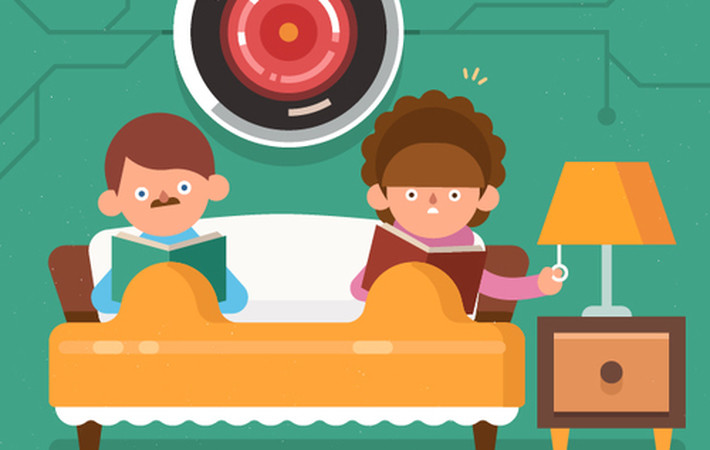
Published on 12/30/2016 | Use Cases
The smart home technology boom is upon us. Despite lucrative projections for the market, and ever increasing numbers of connected devices, we have yet to witness much social impact from consumer adoption into the home. As a potential tipping point looms, there are several debates surrounding privacy, integration and other technical issues. Yet, there seems to be less speculation regarding why consumers still haven’t bought into the hype, nor how domestic life has improved. Considering how personal the home is, should it be concerning that those advertising these products discuss quality of life less than data, energy and ‘security’? Is the adoption of the Internet of Things into our homes inevitable, or is it already here?
The smart person returns to their certified ‘Internet - of -Things‘ smart home after a long day at work. The smart security system senses that the smart person is alone and initiates the ‘Friday Night In’ sequence. Inside, an intercom with a standardized motherly voice suggests that the smart person might want to order in tonight. The smart person unloads their things in the kitchen where the smart stove displays a selection of take out, rather than it’s default recipe guide. Following the arrival of the food, the smart person retreats to the living room to wind down, and watch some TV in their underwear. The smart TV prepares a selection of Netflix marathons categorized by mood. The smart person chooses: ‘Looking to be cheered up? Comedy Playlist’. Before starting the show, the smart person reviews a set of graphs that display the data from activity and diet throughout the day. A list of tips for smart living is generated at the bottom, one of which reads that based on the amount of consecutive nights that the Smart Person has had alone, they might consider investigating a selection of popular dating sites instead of watching TV tonight. At the slip of a thumb the smart person OKS the request and instantly a set of profiles are displayed, each chosen from a generated list of Smart Person’s tracked preferences. Suddenly, a flurry of pings and messages from other stay-at-home hopefuls fill the screen. The smart home intercom repeats aloud ‘You’ve got mail!’. The smart person fumbles for the remote and - oops” - the TV snaps a selfie in response to the flood of pings. Their image, sitting in their underwear eating noodles appears briefly on the screen before being whisked off into the ether. The flood of messages doubles only to freeze the system, causing the smart home to reboot. The house goes dark. In the now blank screen of the smart TV reflects the image of the smart person again, finally alone.
With all the debate and headlines regarding the Internet of Things, and amounts of devices connected and market valuations - is there anyone left to ask about what will happen to the home once Smart Homes take over? The keeping of a home is one of, if not the oldest traditions that we have as humans. Does the Smart Home mean the end of the home as we know it?
The home is the original place where we build our identity and mark our place in the world - the original profile. Each generation has formed its radical dwellings as their respective marks on the world. We can now look back into those past homes as windows into the past lives of those generations, their values and ambitions. What do our Smart Homes tell us about ourselves? Or perhaps instead, what is it telling everyone else?
The process towards the automated home began almost two centuries ago now. When we first plugged our homes in, the light bulb gave us the night. No longer was man confined to the limits of the sun. The technology offered liberation from the natural hours of the day. Later, appliances replaced tools and everything that moved, or could move, became battery powered. The first generation of the automated home advertised better performance for leisure in exchange. More time for the family, or affording the once confined housewife to pursue her career as well. The automated home liberated us from the need to maintain it.
Now, the technological trend continues to carry us through the next generation into a new domesticity. Although there will always be laments for what has passed, perhaps change isn’t so bad. If there is a new liberation perhaps it is the freedom to stay home. The freedom to sit and allow the world to visit us inside. Freedom from the outdoors. Freedom from each other. Yet, this time, is the freedom coming at a cost?
The home is the original security device - the original firewall. But now, as we allow the entire world to float through our walls and into our homes, have we deflated the entire meaning of our home that has stood for millennia? We speak of security and privacy now in the context of technical systems and hardware. But have we forgotten the origin of what privacy meant? In the spaces where we were once the most intimate, by inviting the world in we are becoming the most exposed. To adopt the Smart Home, must we forfeit the home?
Given the acceptance worldwide that privacy is dead, these thoughts may be obsolete falling on ears of developers and web designers. The point though is to fundamentally question what the Smart Home is offering us in exchange for what we must give it. Effectively, is the trade worth it? Will domestic life improve as it did during the first generations of automation? Or, how do we ensure, especially as the community who may be taking part in that change, that some amount of domesticity is salvaged?
This post originally appeared in Toptal blog